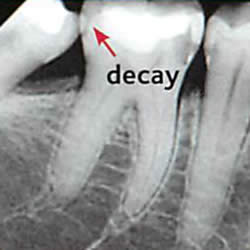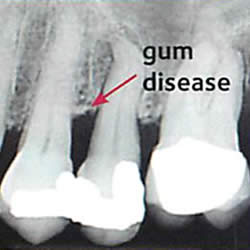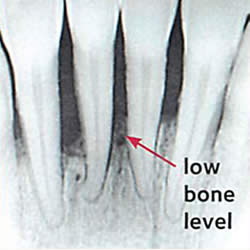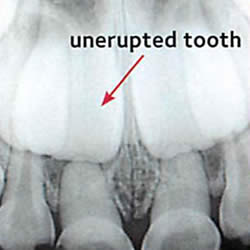Low Radiation Radiography
Our office utilizes Digital Radiography for all intra-oral X-Rays. The advances of digital X-Rays are they emit very low radiation (50-70% less than film X-Rays), images are available in seconds, ability to enlarge and manipulate images to help with diagnosis, no need for developing chemicals thus more environmentally-friendly and images can be readily printed and sent to other Dentist for consultation.
Following is our guide to the most commonly asked Low-Radiation Digital Radiography questions.
Many diseases of the oral cavity (which includes the teeth and surrounding tissues and bone) cannot be seen when the dentist examines your mouth visually.

Dr. Perrott’s Guide to Digital Radiography
Why are dental x-rays needed?
Many diseases of the oral cavity (which includes the teeth and surrounding tissues and bone) cannot be seen when the dentist examines your mouth.
An x-ray exam may help Dr. Perrott see:
- Small areas of decay between the teeth or below fillings
- Bone damage from a tooth infection (such as an abscess) or a cyst
- Bone loss due to periodontal (gum) disease
- Developmental defects
- Some types of tumor
- The effects of trauma
- The position of unerupted teeth in children and adults
Finding and treating dental problems at an early stage can save time, money and unneeded discomfort and help prevent more serious health problems. X-ray images may be able to help Dr. Perrott detect damage and disease not visible during a regular dental exam. If you change dentists, you usually can arrange to have copies of your x-ray images sent from your previous dentist to Dr. Perrott. If you are not able to, Dr. Perrott may take x-rays for the reasons listed above, so he can compare them with future x-ray images.
How are digital dental x-ray images made?
Digital imaging uses an x-ray machine like the used for traditional dental x-ray images made with film. But, instead of using film in a plastic holder, digital images are made using a small electronic sensor that is placed in your mouth to capture the x-ray image. Computers are a part of daily life. They also plan an important role in our dental office.
We use computers to track your appointments, treatment details, and insurance records. We also use them to capture, store and transmit your dental x-ray images. Our practice uses digital x-rays because they have many benefits over film x-rays. Digital x-ray images can be simpler to make, provide enhanced pictures and can save time for our dental team. They also make it easier for us to show these images to you, our patient.
Why do we take digital x-ray images?
There are many benefits to using digital dental x-ray images.
- When the digital x-ray image is exposed, it can be sent directly to a computer and viewed right away. For x-ray film to be exposed, a staff member must process it in special chemicals. This takes a few minutes.
- Digital x-rays are environmentally friendly. They eliminate the need for film and film processing chemicals.
- Digital x-ray images may require less radiation.
- Digital x-ray images can be enlarged on the computer screen. This makes it much easier for you and Dr. Perrott to see the pictures. Traditional x-ray films are viewed at actual size.
- Digital x-ray images can often be corrected without having to make another x-ray exposure.
- Our office can print or copy your digital x-ray images. We can also send them electronically to insurance companies, which may help claims get processed faster.
Are dental x-rays safe?
Dental x-ray exams require very low levels of radiation exposure, which makes the risk of potentially harmful effects very small. A set of Bitewing X-ray images creates only a small fraction of the radiation you are exposed to when flying on an airplane. Dental x-ray tools and techniques are designed to limit the body’s exposure to radiation.
Our practice takes steps to limit the area exposed during a dental x-ray exam, including: 1) limiting the size of the x-ray beam to the size of the film or sensor being used; 2) using a leaded apron and thyroid shield that x-rays cannot pass through.
Have questions?
Ask our office staff. More information about dental x-rays and other imprtant oral health issues can be found at ICON American Dental Association website.





